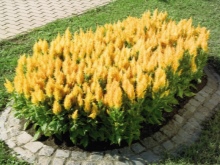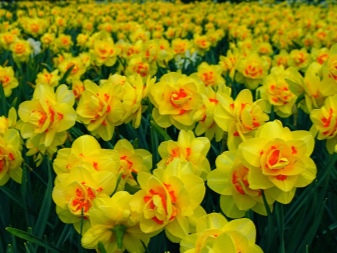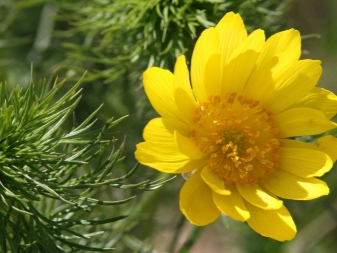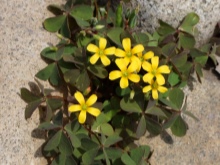Overview of yellow garden flowers

Yellow flowers represent joy and prosperity, and rich bouquets made from them speak of a wish for well-being and sunny days. Growing yellow flowers in a garden or flower bed will cheer up any gardener. In planting, you can combine both annual and perennial crops. They will bloom in a different sequence, making your flower garden bright and spectacular.



Overview of perennial flowers
Of course, perennials are more convenient, it is enough to plant them once, and then just take proper care of them. They are more robust than annuals and less demanding. Among them are bulbous species. They get along with any plants and are the first to delight us with their flowering. The yellow climbing, ground cover and shrub species will give you a sunny mood for the whole season.
Iris
It is also called a cockerel or a killer whale. The plant is perennial, belongs to the genus Iris. There are about 700 different species in the genus. The genus has both bulbous and rhizome species, dwarf and gigantic in size. Very early varieties can be distinguished in terms of flowering time. These are the irises of Juno. They begin to break through even before the snow melts. Native to regions with frequent drought, they do not leave dry leaves after the end of flowering and do not hide under other plants.
Garden irises are of various types and sizes. They are very unpretentious, tend to grow strongly. Flowering begins in May and lasts until June. Plants love sunny locations and fertile soil. Have a lovely sweet aroma during flowering.

Siberian iris is distinguished by thin leaves, grows well, has a bundle-like bush. It begins to bloom in May, does not like stagnant moisture. Frost-resistant variety, unpretentious in care.

Swamp iris grows near places with high humidity. Ideal for pond decoration. Due to excess moisture, it has large flowers and grows up to one and a half meters. Flowering begins in mid-summer and lasts about two weeks.


Narcissus
This is another common plant, it is unpretentious in care, has a bulbous structure of the root system and a large number of varieties. It belongs to the amaryllis family. It has a unique feature - inside a large flower there is a second, smaller one. This interesting characteristic is unique to narcissists. The culture grows on almost any soil, but only in a sunny place. In the sun, the flowers will be larger and more abundant. Propagated by dividing the bulbous rhizome, takes root well.


Tulip
Representative of early flowering plants of the lily family. Hybrid yellow varieties bloom in April for about a week. It grows in any soil, but prefers fertile soil. It does not require a transplant for several years. It propagates well by bulbs, which ripen by autumn. The tulip flower is shaped like a glass and exudes a delicate aroma that cannot be confused with anything. The plant loves light and moisture, the size of the buds and the flowering period depend on this.
Among the yellow varieties of tulips are Golden Apeldoorn, Hamilton, Monte Carlo, Yellow Crow, Mon Amour.



Adonis
The plant is a beautiful bush with glossy leaves, like branches of a Christmas tree, up to 50 cm high. The flowers are small, up to 7 cm in diameter, similar to chamomile, but the petals are two-layered. Adonis is a member of the buttercup family. Flowering begins in May, simultaneously with the appearance of leaves, and lasts until mid-June. Likes to grow in sunny places, does not tolerate transplanting. It takes root well on moist, fertile soils. It grows rather slowly and has a seed propagation method.


Sedum caustic (sedum)
The plant belongs to the jumbo family. Has special fabrics for moisture reserve. The tiny flowers of this plant are collected in umbellate inflorescences and form a fine carpet. The culture has spread stems, grows up to 15-30 cm in height. The sedum is well tolerated by prolonged drought and severe frosts. Luxurious bloom begins in early summer and lasts a little less than two months. Shoots root easily when in contact with the ground, but sedum reproduces well with seeds.
Prefers to grow on a sunny elevation with fertile soil. It is an excellent decor element for alpine slides, looks beautiful in the country.


Pupavka dyeing
This plant with branched stems and a powerful root system resembles a chamomile. It reaches a height of 75 cm. Flowering begins at the end of summer and lasts almost the entire season. Prefers to grow in the sun, does not tolerate excess moisture. In the first year, only a bush grows, without flowering, in the second year, the navel begins to bloom in single yellow baskets. Large inflorescences are about 3 cm in diameter. The flower propagates well by seeds, dividing the bush. Some varieties are used in traditional medicine.

Primrose
The plant belongs to the primroses family. Reaches a height of 20 cm. Differs in velvety leaves collected in a rosette. Flowering begins in early spring, in April, and lasts until June. Funnel-shaped flowers are collected in spherical inflorescences. Prefers to grow in partial shade on fertile soils, without stagnant water.
Reproduction takes place by dividing the rhizome or seeds. In one place it can grow up to 4 years. Prefers top dressing, loose soil. Differs in frost resistance.


Lily
Bulbous plant with beautiful, large, bright yellow inflorescences located on a thin stem. Lilies prefer well-drained, fertile soil. Blossom beautifully in the sun. They love top dressing and rare watering. They tolerate winter frosts well. Flowering usually occurs in July and lasts about a week. After its completion, the faded inflorescences are removed.


Other
Consider other crops, which also belong to common perennials and are widely used in the decoration of garden plots.
Loosestrife
The verbeinik grows up to a meter and has a branched bush with erect or creeping shoots. Its second name is lysimachia. The flowering is dense, beautifully arranged in the bush. The culture belongs to the primrose family. Yellow shades are inherent in the following varieties.
- Common loafers. It has a height of about a meter, blooms from mid-June to July.
- Loose worm. Produces lush, light-leaved shrubs and blooms profusely in yellow from mid-summer to mid-autumn.
- Loose loaf Differs in ground cover shoots with single inflorescences. It grows rapidly, displacing neighboring plantations.



Kislitsa
In the wild, this plant is found in South America and Europe. The leaves are like clover. It is believed that the plant brings good luck and serves as a talisman. The leaves are beautifully arranged on thin shoots, gathered in a bunch at the base. They can be green and maroon, depending on the variety. During the day they are wide open, like the wings of a butterfly, and in the evening they fold. The plant loves moisture, easily multiplies by dividing the bulbous rhizome.
- Oxalis hedisarium - This is a semi-shrub that reaches a height of 30 cm. The shoots are short, about 4 cm. The burgundy leaf has bright edges and a central vein. This variety differs in bright yellow flowering.
- Giant oxalis - the most powerful species, reaches a height of up to 2 meters, the branches are lowered, the leaves are very large. The crown is similar to lace, decorated with apricot flowers measuring 20 cm.
- Nasturtium oxalis Is another subspecies that boasts a spectacular yellow bloom.



Chrysanthemum
It is a perennial plant from the Aster family. The shrub can grow up to 70 cm in height, and the flowers are both small and large, depending on the variety. Chrysanthemums love sun and moisture. Inflorescences can be double, simple, pompom and others. Plants propagate by cuttings, dividing the rhizome. Flowering begins in July and can last until autumn.



Annual plant species
Annuals are distinguished by their splendor flowering. They reproduce by seeds and are practically not exposed to diseases. Let's see which flowers are the most popular among gardeners.
- Marigold. A beautiful plant with large, double flowers. The height depends on the conditions, in general, the culture reaches 60 cm. Marigolds grow in any conditions, but they prefer the sun and moisture. Propagated by seeds, which are simply sown in the ground and sprout in two weeks.


- Asters. They are a decoration of the autumn garden. Breeders have bred a huge number of varieties of different shapes. Asters are not too picky about light; they grow on slightly alkaline soils without excess nitrogen.

- Petunia. Unpretentious annual plant. A large number of shoots are covered with funnel-shaped flowers. The culture is propagated by small seeds, which can sprout by self-seeding. Petunia loves sun and abundant watering.


- Eschsholzia Californian. This flower reproduces well by self-seeding, will grow in one place for several years. The plant is similar to poppy, which is why it is also called the California golden poppy. For maximum effect, it is planted in groups. Escholzia blooms in mid-summer, about two weeks.

- Ranunculus. This plant from the buttercup family has another name - garden buttercup. The flower is very similar to a peony or a rose, only it is smaller and with a yellow tint. The flowers are double or semi-double, the diameter is up to 8 cm. The height of the flower does not exceed 70 cm. The rhizome consists of tubers, the shoots are strong, with dissected leaves. Ranunculus prefers to grow in the shade in swampy ground. Does not tolerate drafts, propagates by seeds.


How to arrange a flower bed?
When decorating a flower bed with predominantly yellow flowers, select species that begin to bloom, replacing each other. For example, tulips and daffodils will bloom first, followed by lilies and irises. Marigolds and escholzia, petunia and oxalis will bloom from mid-summer to late autumn. The autumn composition will be complemented by the blossoming of asters. Try to plant marigolds and asters in a group planting, so they will look more impressive.
This can be an even row of plantings or a circular planting, which creates the appearance of a yellow ball.

Examples in landscape design
The yellow tint in landscape design has a special character. It is associated with warmth and joy, a good atmosphere. Beautifully yellow flowers will be in harmony with conifers. Among the tall thujas, marigolds and asters will look spectacular.

The borders in the garden can be decorated with a solid line of sorrel. In the background, it is better to plant lilies and dilute the yellowness with red and blue flowers. Poppies and roses will perfectly fit into such a composition.

Against the background of a green lawn, you can plant adonis or stonecrop in groups.

It would be nice to decorate an alpine slide with petunia and loosestrife.

Irises are suitable for decorating the central entrance. It is recommended to plant them in tall flowerpots.
For petunias, it is better to choose hanging pots.

Nature has given us a very diverse world of flowers. Each shade is beautiful and polysemantic in its own way. If you are a favorite of yellow plants, then do not be afraid to experiment with planting.Try it, fantasize, because yellow is the color of wealth and success.


For general principles and a step-by-step guide to flower garden design, see below.







































































































The comment was sent successfully.